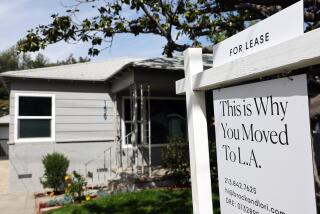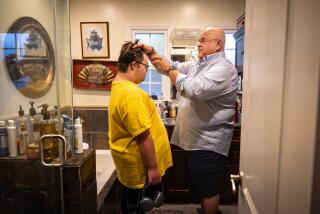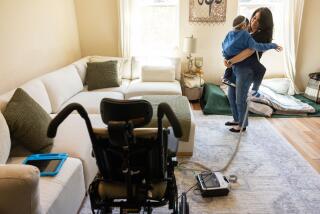Elderly May Finally Get Their Due in State Funding
SACRAMENTO — Frail senior citizens in San Diego County can tap into an array of state-funded services designed to keep them out of nursing homes as long as possible--transportation, day care, even moral support for their families.
But equally needy elderly in Ventura County find no such cushion.
San Francisco County offers many choices, while across the bay, Contra Costa County has few. Fresno County provides several options; neighboring Madera and Tulare counties offer none.
Such inconsistencies can be identified all over California, primarily because of years of inconsistent funding. Even in Los Angeles County, home to more people over 60 than anywhere else in California--1.3 million, or about one in seven people--per-capita funding is a fraction of that in less populated areas of the state.
This year, state politicians seem to have noticed the disparities. Senior citizens, remembered in up to $100 million worth of new budget proposals and the inspiration for a dozen pending bills, may finally be getting some respect in Sacramento.
Could 1998 signal a renaissance for California’s elders, whose ranks are expected to double in the next two decades? Senior citizens’ advocates are cautiously optimistic.
“It’s the first time we’ve had this much attention for a long time,” said Barbara Affolter, a retired school administrator from Temecula and member of the California Senior Legislature for the last five years.
Credit for the changing political perspective goes to a term-limited governor eyeing the White House, a new coalition of previously competing senior citizen advocates and a Legislature dominated by aging baby boomers.
The proposed funding would first and foremost make services more uniform from region to region. Every county would have a day-care center for senior citizens, a referral service and additional resources to combat elder abuse. Under the Legislature’s plan, an estimated 280,000 additional senior citizens would be helped.
Even if approved in its entirety, the added support will not come close to addressing the need. It only “looks like an avalanche because we’ve been in the desert,” said Lu Molberg, an advocate for the elderly.
How the inequities emerged in the first place is Politics 101.
Given short shrift for years at budget time, services for the elderly grew by fits and starts as the result of state-funded pilot programs. Those experimental pilots became juicy pork, highly coveted and jealously guarded by politicians courting senior citizens’ votes.
Because no significant additional money followed, the model programs were not cloned statewide, said Molberg, president of the California Assn. of Area Agencies on Aging and founder of a new alliance of senior citizen and disabled groups, the Coalition for Integrated Advocacy.
If politics as usual created the problem, she hopes the politics of change may begin to solve it.
For the first time last year, 18 senior citizen groups, ranging from the California Senior Legislature to the Foster Grandparent Program, joined forces to lobby for common interests.
With so little money available in the past, they often had found themselves fighting over the scraps. Last year, many saw an opportunity in the lifting recession and growing public awareness about aging baby boomers.
Led by Molberg, the Coalition for Integrated Advocacy also embraced nine related organizations, including several representing disabled adults.
In doing so, they piggybacked on the experience of people like Peggy Hecker, 61, who was disabled by polio at 12 and is now among those pushing for a bill to increase in-home care.
She lives in the Bay Area and qualifies for the maximum nine hours a day of government-funded care, but needs help around the clock. Hecker says she would take her own life before she would go into a nursing home.
A Timely Effort
Hecker considers it only natural that advocates for increased state-paid services for the elderly would look for lessons learned by the disabled.
“We disabled who have been disabled for some time, we’ve been doing this for years and years and years, so we know who to call,” she said. “But the elderly who suddenly become disabled don’t know what to do.”
Molberg urged the coalition to begin meeting with policymakers and legislators even before its vision statement was complete. Members soon realized how timely their effort really was, as many of their targets shared personal stories of aging parents.
State Sen. John Vasconcellos (D-Santa Clara), head of the Senate Select Committee on Aging, said the group opened his eyes to the urgency of the problem. But it also got him thinking about his own situation.
“I’m 66, my mother’s 93,” he said. “She’s had five falls in the last year, she’s profoundly intact and perfectly independent, but I’m certainly more alert to this because of her and because of my own age.”
Vasconcellos agreed to draft a strategic planning bill based on the coalition’s concern that, although much is known about the coming population explosion of the aging, little is known about what services they will need and want.
For Molberg, the prospect of tangible gains from the coalition’s first forays is encouraging, but hardly a victory. She compares California to other states and comes up short.
Oregon, Washington and Colorado, for example, are renowned for using state money to create alternatives to nursing homes and for their successful pressure on the federal government to bend stringent Medicaid rules that have long favored institutional care.
Because federal Medicaid reimburses the state for serving the poorest senior citizens, some results are suggested in the Medicaid breakdown. In Oregon, for instance, nearly 40% of Medicaid money goes to in-home care and less than 60% to nursing homes, according to the Urban Institute. In California, the ratio is closer to 80% for nursing homes and 8% for home care.
That is the kind of contrast the coalition intends to highlight in its three-to-five-year proposal for improving options for California’s aging, scheduled for release this fall, Molberg said. “Our mantra [is], ‘We’ll stay together until it’s all done.’ ”
So far, Gov. Pete Wilson and legislators appear to be listening. Wilson has proposed spending $40 million more on various senior citizen programs, while the Legislature wants to increase that to $100 million--more than double what was spent this year. Both would make sure every county offered services including:
* Adult day-care programs that provide assistance ranging from physical therapy to counseling and a related program supporting senior citizens who have Alzheimer’s disease.
* Adult protective services programs that monitor and prevent abuse of the elderly.
* Case management, which helps families determine and meet their senior citizens’ needs to prevent or postpone admission to institutions.
In addition, legislation wending its way through committees includes two bills that would create more centers of all-inclusive community care for the elderly--the sort of one-stop shopping locales that are now rare.
Several other bills would ease restrictions on payment of workers who care for the elderly and the disabled in their own homes. One would train CalWorks recipients--those on welfare being prepared for work--for in-home care; another would require fingerprinting of all such workers.
Feelings of Frustration
Still, senior citizens’ advocates describe the proposals as a down payment.
Molberg uses her own turf--she runs the Riverside Agency on Aging office--as evidence of the problem. Although the county has one of California’s fastest-growing senior populations, state funding provides for just three adult day-care programs--only one of them for Alzheimer’s patients--and none of the case management and linking of programs that tie disparate services together.
“We have so many gaps,” Molberg said.
Although privately funded programs have filled some gaps, they are driven by the market--not need. The commercial centers are too expensive for low-income senior citizens and the nonprofit ones are frequently full.
“Frustration is the key word,” said Margaret Gelchie of Simi Valley, who searched for years before finding a private nonprofit day-care program for her 75-year-old mother. During those years, Gelchie watched her mother become more and more withdrawn as heart problems and memory loss took their toll.
“You feel you’re failing your parent,” she said.
Today there are no openings at the nonprofit Fitzgerald Senior Day Support Center in Thousand Oaks, where Gelchie takes her mother. Director Lynn Engelbert said that until this year she had the impression “legislators were thinking if they withdrew the services, the churches and the nonprofits would pick up the slack. . . . We’re doing our best, but we need support.”
One major problem with the budget proposals is that they assist the have-not regions first, making sure every county has a full range of choices. The state’s nonpartisan legislative analyst’s office finds that solution flawed.
Riverside would get its needed case management, analysts pointed out, but neighboring Orange and San Bernardino counties would receive no increase because they already have case management programs. The state Department of Aging’s own tally of potential clients indicates there are more unserved senior citizens in Orange and San Bernardino counties than in Riverside.
Likewise, Los Angeles County would get no additional case management funds, even though its five current programs serve only 1,800 of the estimated 17,000 disabled elderly living there, leaving it with the largest unmet need in the state.
While that problem is worked on, the overall issue of state-funded programs for the elderly will remain prominent at the Capitol, Affolter said.
“Seniors have been knocking at that door for a very long time, and very hard, too,” she said. “Now they can’t ignore it. When you open the paper nowadays, more and more articles are based on senior people--the baby boomers and what’s going to happen when they get to be 55 to 60 years of age.
“They have to take a look at these things, because they’re imminent.”
More to Read
Sign up for Essential California
The most important California stories and recommendations in your inbox every morning.
You may occasionally receive promotional content from the Los Angeles Times.










